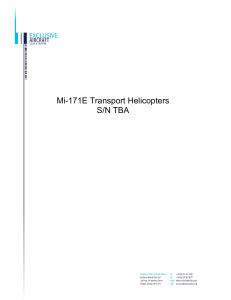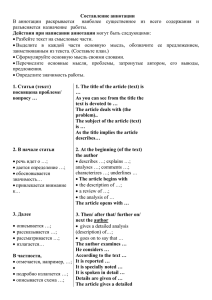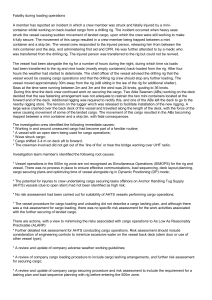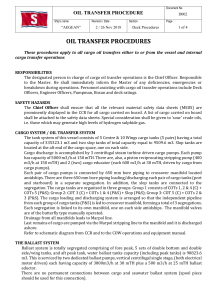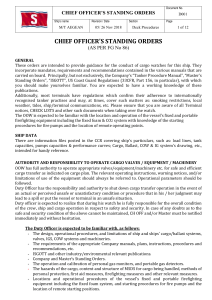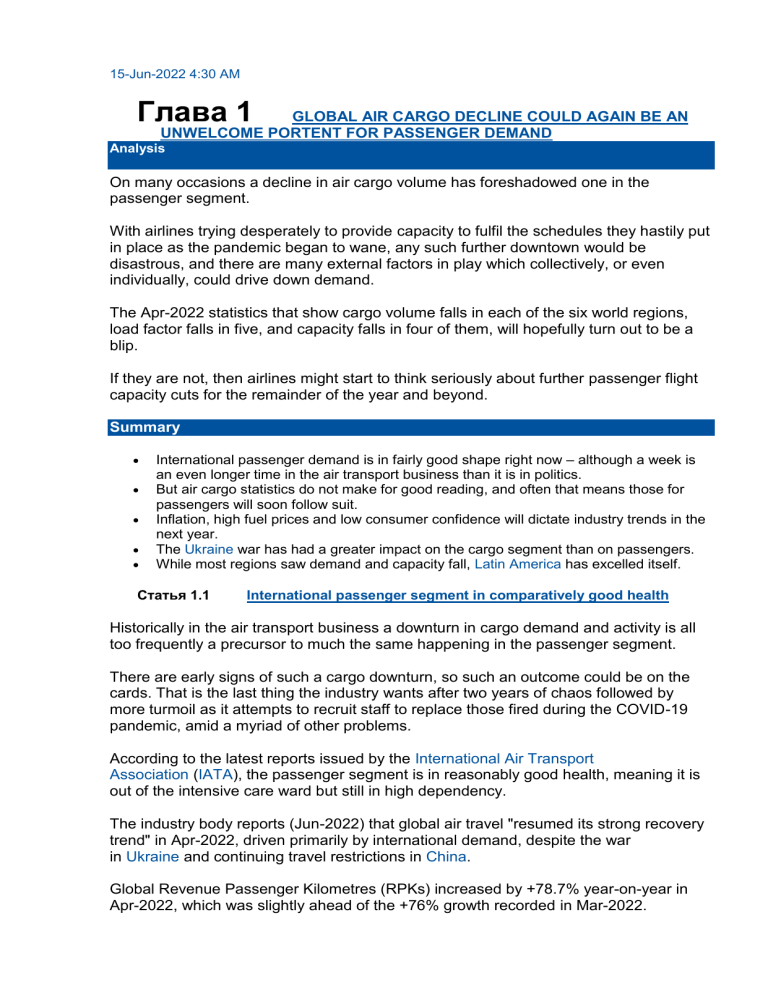
15-Jun-2022 4:30 AM Глава 1 GLOBAL AIR CARGO DECLINE COULD AGAIN BE AN UNWELCOME PORTENT FOR PASSENGER DEMAND Analysis On many occasions a decline in air cargo volume has foreshadowed one in the passenger segment. With airlines trying desperately to provide capacity to fulfil the schedules they hastily put in place as the pandemic began to wane, any such further downtown would be disastrous, and there are many external factors in play which collectively, or even individually, could drive down demand. The Apr-2022 statistics that show cargo volume falls in each of the six world regions, load factor falls in five, and capacity falls in four of them, will hopefully turn out to be a blip. If they are not, then airlines might start to think seriously about further passenger flight capacity cuts for the remainder of the year and beyond. Summary International passenger demand is in fairly good shape right now – although a week is an even longer time in the air transport business than it is in politics. But air cargo statistics do not make for good reading, and often that means those for passengers will soon follow suit. Inflation, high fuel prices and low consumer confidence will dictate industry trends in the next year. The Ukraine war has had a greater impact on the cargo segment than on passengers. While most regions saw demand and capacity fall, Latin America has excelled itself. Статья 1.1 International passenger segment in comparatively good health Historically in the air transport business a downturn in cargo demand and activity is all too frequently a precursor to much the same happening in the passenger segment. There are early signs of such a cargo downturn, so such an outcome could be on the cards. That is the last thing the industry wants after two years of chaos followed by more turmoil as it attempts to recruit staff to replace those fired during the COVID-19 pandemic, amid a myriad of other problems. According to the latest reports issued by the International Air Transport Association (IATA), the passenger segment is in reasonably good health, meaning it is out of the intensive care ward but still in high dependency. The industry body reports (Jun-2022) that global air travel "resumed its strong recovery trend" in Apr-2022, driven primarily by international demand, despite the war in Ukraine and continuing travel restrictions in China. Global Revenue Passenger Kilometres (RPKs) increased by +78.7% year-on-year in Apr-2022, which was slightly ahead of the +76% growth recorded in Mar-2022. Статья 1.2 Domestic travel decrease dictated by events in China Domestic passenger travel decreased by -1%, a reversal from the +10.6% increase in Mar-2022. But IATA insisted that the result "was driven entirely by continuing strict travel restrictions in China", where domestic traffic decreased by -80.8% but where there has been a dramatic recovery in domestic seat capacity – almost a doubling of it – since the end of May-2022, when some of those restrictions were eased (green line on chart below). China: weekly total domestic seat capacity, 2019-2022* (projected) Source: CAPA - Centre for Aviation and OAG International RPKs increased by +331.9%, which was a notable acceleration from the +289.9% growth in Mar-2022. IATA noted that several key markets had even exceeded pre-pandemic levels, including Europe-Central America, Middle East-North America and North AmericaCentral America. New flexible entry conditions in previously restricted Asian countries allowed for foreign arrivals, fostering higher growth rates in the region. However, the divergence in the pace of the recovery between Asia Pacific and other markets persists. Статья 1.3 Events of concern include inflation, high fuel prices and low consumer confidence IATA noted inflation as one of several "points of concern for the coming months." Inflation is touching double figures in many developed countries, and as of May-2022 is well into them in four key countries – Brazil (11.7%); Russia (17.1%); Argentina (56.0%); and Turkey (73.5%). In the latter two cases that is hyperinflation (over 50%), and there are presently eight countries in that predicament. They will assuredly be joined by others before long. Strangely, China has the lowest inflation rate of developed countries (2.1%). The highest is Venezuela at 222%. (Source: Trading Economics). Other points of concern naturally include high fuel prices. On 10-Jun-2022 a barrel of Brent Crude was trading at USD123.5, not the highest ever (that was USD147 in Jul-2008), but worryingly close to it and still going up. Also ‘low consumer confidence’, which is a function of the factors mentioned above. In the UK, where this article is written, media reports suggest that “nightmare” queues at airports to clear security at one end of a journey or to clear Border Control and retrieve baggage at the other, together with flight cancellations and delays being measured in days rather than hours, topped off with anticipated airfare increases of +70% in the summer of 2022 – all mean that for many the ‘staycation’ will again take priority this year. This brings into question IATA’s assertion that international bookings "show a high willingness to travel abroad" and that the positive trend is expected to continue throughout the 2022 northern summer. The traffic figures have certainly been much better as many travel restrictions were lifted, but that should not necessarily be taken as a definitive indicator of future trends. Статья 1.4 Other health-related events waiting in the wings? In such circumstances another unexpected blow can have severe repercussions for recovering demand. For example, the World Health Organisation, which is attempting to take over global responsibility from sovereign nations for setting disease control parameters (including travel restrictions and ‘lockdowns’), began talking recently about "washing your hands frequently, avoiding contact with infected people and wearing a face mask", being measures to minimise the spread of monkeypox. Shades of Mar-2020. Nevertheless, the passenger segment is without doubt in a better place than it was, with almost all statistics registering positive. That isn’t the case, though, for the cargo segment. Статья 1.5 Fall in global air cargo demand in line with expectations IATA reports decreases in global air cargo demand and capacity in Apr-2022, driven by "a challenging operating backdrop" – again caused specifically by the effects of the COVID-19 Omicron variant in Asia and the Russia-Ukraine conflict. New export orders, which are a leading indicator of cargo demand and world trade, are now shrinking in all markets except the US. Global demand in Cargo Tonne Kilometres (CTKs) decreased by -11.2% year-on-year in Apr-2022. International CTKs decreased by -10.6%. Compared to Apr-2019, demand decreased by -1%. In another words, cargo demand is decreasing at a greater rate compared to last year, when the coronavirus pandemic held a vice-like grip, than compared to the good times benchmark year of 2019. Capacity also decreased by -2% year-on-year. Asia recorded the largest regional drops in capacity. Статья 1.6 It isn’t just wheat and sunflower oil – Russian and Ukrainian airlines removed from the cargo supply chain The conflict in Ukraine, which shows no sign of coming to any sort of conclusion and has degenerated further into a highly destructive war, led to a fall in cargo capacity serving Europe as several airlines based in Russia and Ukraine were key cargo players in the business. Supply chain disruptions due to the conflict are also adding to downward pressure on trade generally. Статья 1.7 volume China’s never-ending 'zero COVID' policy has shattered cargo The zero-COVID policy in China led to capacity challenges due to flight cancellations resulting from labour shortages. Lockdowns brought much of Shanghai to a standstill. At the time of writing, lockdowns had been eased in that city for the first time in two months, but were then reintroduced in some suburbs, apparently in yet another fruitless attempt to achieve the aims of that policy. Shanghai Pudong International Airport: annual traffic, cargo volume/growth, 2019-2022 (Jan-Apr) Source: CAPA - Centre for Aviation and Shanghai Pudong International Airport reports. New export orders are now shrinking in all markets except the US. Global goods trade has continued to decline in 2022, with China's economy growing more slowly due to COVID-19 lockdowns and other factors. Economic growth in China (GDP percentage), Mar-2019 to Mar-2022 Source: Trading Economics/National Bureau of Statistics of China. In May-2022 Fitch Ratings cut its forecast for China’s 2022 GDP growth to +4.3%, from +4.8%. Meanwhile, the agency revised its 2023 growth forecast slightly higher, to +5.2% from +5.1%, on the assumption that the government will phase out its ‘dynamic zero-COVID’ policy only gradually over the course of 2023. Статья 1.8 IATA's Willie Walsh sees at least some cause for optimism IATA Director General Willie Walsh said, "The combination of the war in Ukraine and COVID-19 lockdowns in China have pushed up energy costs, intensified supply chain disruptions, and fed inflation". The operating environment is challenging for all businesses, he said, including air cargo, adding, “But with China easing lockdown restrictions, there was cause for some optimism and the supply/demand imbalance is keeping yields high". (I.e. higher fares – the next big turn-off for international travellers). Статья 1.9 crazy Asia Pacific the worst performing region while Latin America goes The regional breakdown in Apr-2022 is as follows: 1.9.1 Asia Pacific – the weakest performer Asia-Pacific airlines saw their air cargo volumes decrease by -15.8% in Apr-2022 compared to the same month in 2021. This was the weakest performance of all regions, and significantly slower than the previous month (-5.1%). Airlines in the region have been heavily impacted by lower trade and manufacturing activity due to Omicron-related lockdowns in China. Because of this, available capacity in the region fell -19.4% compared to Apr-2021, which was the largest drop of all regions. 1.9.2 North America – demand down but capacity up, and North America–Europe remains a strong market North American airlines posted a -6.6% decrease in cargo volumes in Apr-2022 compared to Apr-2021. Demand in the Asia-North America market declined significantly; however, other key routes such as Europe-North America remain strong. Capacity was up +5.2% compared to Apr-2021. Several airlines in the region are set to receive delivery of freighters in 2022, which should help address pent-up demand on routes where it is needed. 1.9.3 Europe – ‘within-Europe’ market particularly impacted by Ukraine war European airlines experienced a -14.4% decrease in cargo volumes in Apr-2022 compared to the same month in 2021. The Within-Europe market fell significantly – down -24.6% month-on-month. This is attributable to the war in Ukraine. Labour shortages and lower manufacturing activity in Asia due to Omicron also affected volumes. Capacity fell -0.2% in Apr-2022 compared to Apr-2021. 1.9.4 Middle East – supply chain issues contribute to volumes but capacity increased Middle Eastern airlines experienced an -11.9% year-on-year decrease in cargo volumes in Apr-2022. Significant benefits from traffic being redirected to avoid flying over Russia failed to materialise. This is likely due to persisting supply chain issues in Asia. Capacity was up +6% compared to Apr-2021. 1.9.5 Latin America – the strongest performer; huge increase in flown volume and capacity Latin American airlines reported an increase of +40.9% in cargo volumes in Apr-2022 compared to the 2021 period. This was the strongest performance of all regions. Airlines in this region have shown optimism by introducing new services and capacity, and in some cases investing in additional aircraft for air cargo in the coming months. Capacity in Apr-2022 was up +67.8% compared to the same month in 2021. 1.9.6 Africa – previous month’s growth trend reversed African airlines saw cargo volumes decrease by -6.3% in Apr-2022 compared to Apr2021. This was significantly slower than the growth recorded the previous month (+3.1%). Capacity was -1.5% below Apr-2021 levels. 'We are the champions' – CTKs, change in load factor and load factor level in Apr2022: Latin America easily lifts the trophy Source: IATA. So while these results vary considerably by region, it is only Latin America that can take any satisfaction from them. If this data continues to show a decline in the following months then concern will grow about how passenger bookings for the Oct-2021 to Mar-2022 period, and the full year beyond that, might follow suit. NB. The full reports from IATA are accessible through the CAPA IATA Profile, News section Статья 1.10 Related Articles
